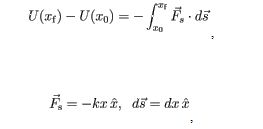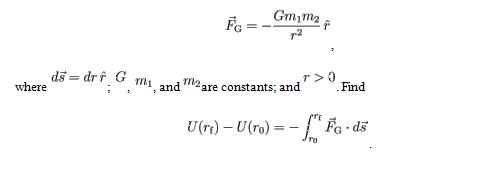Discuss the below:
Potential Energy Calculations
Learning Goal: To understand the relationship between the force and the potential energy changes associated with that force and to be able to calculate the changes in potential energy as definite integrals.
Imagine that a conservative force field is defined in a certain region of space. Does this sound too abstract? Well, think of a gravitational field (the one that makes apples fall down and keeps the planets orbiting) or an electrostatic field existing around any electrically charged object.
If a particle is moving in such a field, its change in potential energy does not depend on the particle's path and is determined only by the particle's initial and final positions. Recall that, in general, the component of the net force acting on a particle equals the negative derivative of the potential energy function along the corresponding axis:
Fx=-dU/dx(x)
Therefore, the change in potential energy can be found as the integral
ΔU=-2∫1F→.ds→
where ΔU is the change in potential energy for a particle moving from point 1 to point 2F→, is the net force acting on the particle at a given point of its path, and ds→ is a small displacement of the particle along its path from 1 to 2.
Evaluating such an integral in a general case can be a tedious and lengthy task. However, two circumstances make it easier:
1. Because the result is path-independent, it is always possible to consider the most straightforward way to reach point 2 from point 1.
2. The most common real-world fields are rather simply defined.
In this problem, you will practice calculating the change in potential energy for a particle moving in three common force fields.
Note that, in the equations for the forces, x^ is the unit vector in the x direction,y^ is the unit vector in the y direction, and γ is the unit vector in the radial direction in case of a spherically symmetrical force field.
A. Consider a uniform gravitational field (a fair approximation near the surface of a planet). Find Express your answer in terms of

B. Consider the force exerted by a spring that obeys Hooke's law. Find and the spring constant is positive.
Express your answer in terms

C. Finally, consider the gravitational force generated by a spherically symmetrical massive object. The magnitude and direction of such a force are given by Newton's law of gravity:
Express your answer in terms of G ,m1 ,m2 , ro,rt and .
U(rt)-U(ro)
